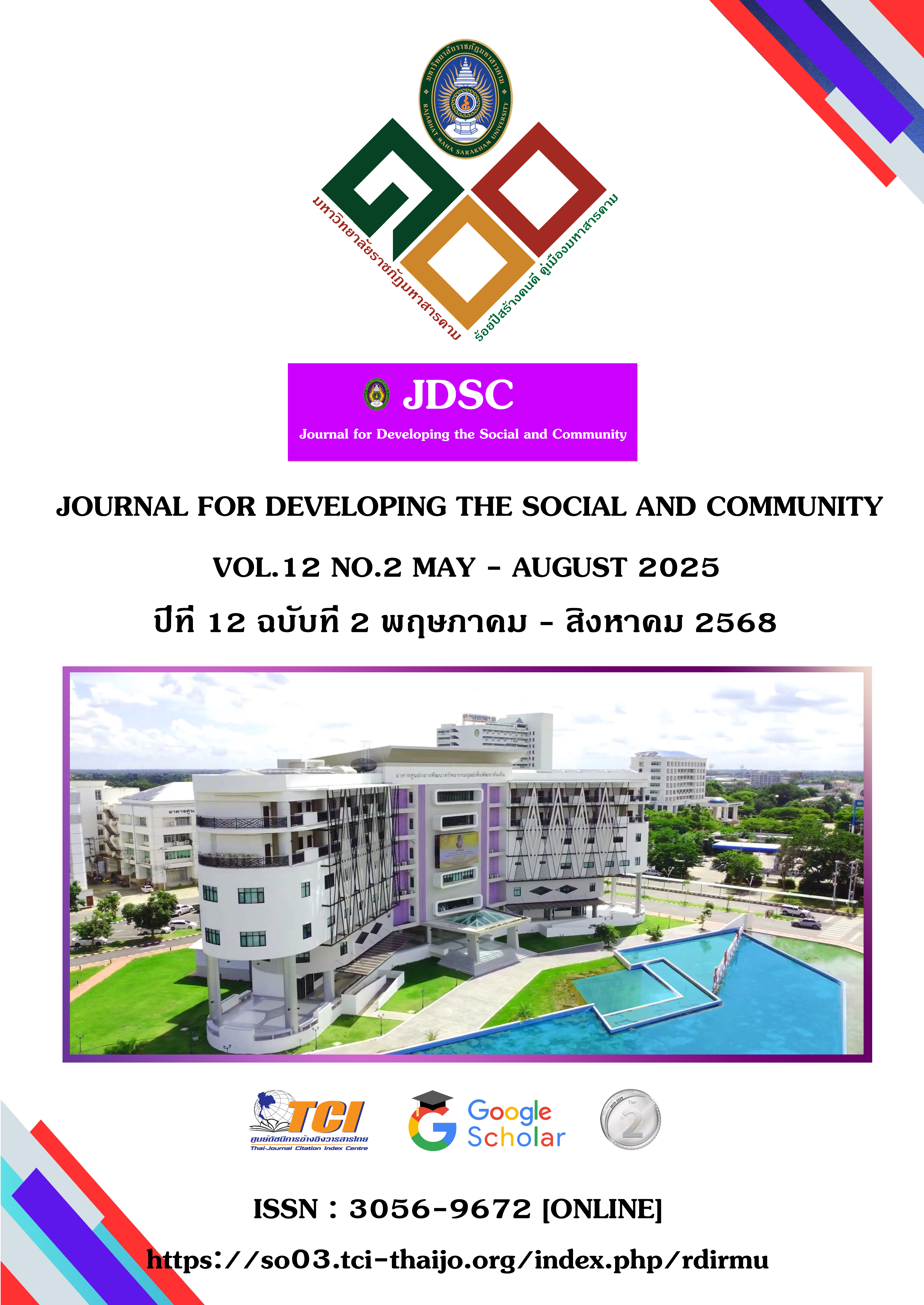Development of the AIRIE Learning Model Based on Active Learning Approach to Enhance Learning and Innovation Skills in Earth and Space Science for Grade 12 Students at Suranaree Wittaya 2 School
Keywords:
AIRIE Learning Management Model, Active Learning, 21st Century Learning Skills, Earth and Space ScienceAbstract
Background and Aims: This research aims to develop the AIRIE learning management model to promote 21st-century learning skills, particularly learning and innovation skills, in the Earth and Space Science course. The objectives of this study are as follows: 1.To determine the effectiveness of the AIRIE learning management model in promoting 21st-century learning and innovation skills in the Earth and Space Science course based on the 80/80 criterion. 2.To examine the outcomes of implementing the AIRIE learning management model in enhancing 21st century learning and innovation skills in the Earth and Space Science course, through the following sub-objectives: 2.1 To compare students’ learning achievement in learning and innovation skills before and after using the AIRIE learning model in Unit 3: Weather and Climate, in the Earth and Space Science subject. 2.2 To evaluate students’ learning and innovation skills after participating in learning activities based on the AIRIE model in the Earth and Space Science subject.
2.3 To investigate students’ satisfaction with the AIRIE learning management model in promoting 21st-century learning and innovation skills in the Earth and Space Science subject.
Methodology: The research was conducted in three phases:
Phase 1 involved the development of the AIRIE learning management model.
Phase 2 consisted of quality verification and model improvement.
Phase 3 focused on the implementation and evaluation of the model’s effectiveness.
The sample group comprised one class of 36 students enrolled in the Earth and Space Science course at Suranaree Wittaya 2 School during the second semester of the academic year 2024. The sample was selected using purposive sampling. The research instruments included: 1) A set of 20 instructional plans for Unit 3: Weather and Climate, covering 20 class periods, along with a user manual for implementing the AIRIE learning management model. 2) A 30-item pre-test and post-test on students’ learning achievement for Unit 3: Weather and Climate. 3) A 24-item assessment form evaluating students’ learning and innovation skills. 4) A 15-item questionnaire measuring students’ satisfaction with the AIRIE learning model. Data were analyzed as follows:
- The effectiveness of the AIRIE learning management model was determined.
- Learning achievement before and after instruction was compared using a t-test.
- The percentage scores from the learning and innovation skills assessment were calculated.
- Students’ satisfaction with the learning model was analyzed using the mean (X̄) and standard deviation (SD), and results were compared against the predefined criteria.
Results: 1. The AIRIE learning management model designed to enhance 21st-century learning and innovation skills in the Earth and Space Science course demonstrated an effectiveness score of 85.65/80.17, which exceeds the established criterion. 2.The students’ learning achievement after receiving instruction through the AIRIE learning model was significantly higher than before the instruction, at the .05 level of statistical significance. 3. After implementing the instructional plans based on the AIRIE learning model, the students’ assessed performance in learning and innovation skills significantly improved. 100% of students achieved performance at a level classified as “good” or higher, which surpassed the predetermined standard. 4.Students who learned through the AIRIE model expressed the highest level of overall satisfaction. The top three aspects with the highest mean scores were: Encouragement for students to express ideas and design innovations (X̄ = 4.87) Use of diverse teaching techniques appropriate to learning activities (X̄ = 4.85) Promotion of effective student collaboration (X̄ = 4.85) Support for students in developing communication skills to present their ideas to others (X̄ = 4.84)
Conclusion: The findings revealed that the AIRIE learning management model achieved an effectiveness score of 85.65/80.17. When implemented to promote 21st-century learning and innovation skills, the model led to a statistically significant improvement (p < .01) in students’ academic achievement in the Earth and Space Science subject. Furthermore, 100% of the students showed improvement in learning and innovation skills, reaching a performance level classified as “good” or higher. Students also reported the highest level of overall satisfaction with the AIRIE learning model.
References
ขวัญชัย ขัวนา, ธารทิพย์ ขัวนา, และเลเกีย เขียวดี. (2561). การพัฒนารูปแบบการเรียนการสอนเพื่อส่งเสริมทักษะการเรียนรูในศตวรรษที่ 21. วารสารมนุษยศาสตร์และสังคมศาสตร์ มหาวิทยาลัยมหาสารคาม, 37(2), 87.
ณัฐวุฒิ จันละมุด. (2554). การศึกษาผลสัมฤทธิ์ทางการเรียนวิทยาศาสตร์และเจตคติทางวิทยาศาสตร์ของนักเรียนชั้นมัธยมศึกษาปีที่ 3 ที่ได้รับการจัดการเรียนรู้แบบโมเดลซิปปาและการจัดการเรียนรู้แบบร่วมมือโดยใช้เทคนิค TGT. วิทยานิพนธปริญญาการศึกษามหาบัณฑิต,
มหาวิทยาลัยศรีนครินทรวิโรฒ.
ทิศนา แขมมณี. (2543). การจัดการเรียนการสอนโดยยึดผู้เรียนเป็นศูนย์กลาง:โมเดลซิปปา ในประมวลบทความนวัตกรรมเพื่อการเรียนรู้สําหรับครูยุคปฏิรูปการศึกษา. คณะครุศาสตร์ จุฬาลงกรณ์ มหาวิทยาลัย.
ทิศนา แขมมณี. (2550). ศาสตร์การสอน: องค์ความรู้เพื่อการจัดกระบวนการเรียนรู้ที่มีประสิทธิภาพ (พิมพ์ครั้งที่ 2). สํานักพิมพ์จุฬาลงกรณมหาวิทยาลัย.
ธีรังกูร วรบํารุงกุล, พรสวัสดิ์ ศิรศาตนันท์, เริงวิชญ์ นิลโคตร และสมปอง มูลมณี. (2561). รูปแบบการจัดการเรียนรู้เพื่อพัฒนาทักษะของผู้เรียนในศตวรรษที่ 21 ด้านทักษะการเรียนรู้ และนวัตกรรมของโรงเรียนในภาคตะวันออก. มหาวิทยาลัยราชภัฏรําไพพรรณี.
ปณิชา ชัยกุลภัทรโชติ. (2563). การพัฒนาแบบวัดทักษะในศตวรรษที่ 21 ด้านการเรียนรู้และนวัตกรรมของนักเรียนชันประถมศึกษา. มหาวิทยาลัยนเรศวร.
วิจารณ์ พานิช. (2555). วิถีสรางการเรียนรู้เพื่อศิษย์ในศตวรรษที่ 21. มูลนิธิสดศรีสฤษดิ์วงศ์.
วีรยุทธ พลายเล็ก และมาเรียม นิลพันธุ์. (2563). การพัฒนารูปแบบการเรียนการสอนตามแนวคิด Active Learning เพื่อเสริมสร้างทักษะและกระบวนการและจิตคณิตศาสตร์สําหรับนักเรียนชั้นประถมศึกษา. (564)
วรพจน์ วงศ์กิจรุ่งเรือง และอธิป จิตตฤกษ์. (2556). ทักษะแห่งอนาคตหม่การศึกษาเพื่อศตวรรษที่ 21. (พิมพ์ครั้งที่ 2). โอเพ่นเวิลตัส พับลิชชิ่ง เฮาส์.
สํานักงานคณะกรรมการการศึกษาขั้นพื้นฐาน. (2553). พระราชบัญญัติการศึกษาแห่งชาติ พ.ศ.2542 และที่แก้ไข. เพิ่มเติม (ฉบับที่ 3) พ.ศ.2553. สํานักนายกรัฐมนตรี.
สํานักงานคณะกรรมการการศึกษาขั้นพื้นฐาน. (2560). ตัวชี้วัดและสาระการเรียนรู้แกนกลาง กลุ่มสาระการเรียนรู้วิทยาศาสตร์ (ฉบับปรับปรุง พ.ศ. 2560) ตามหลักสูตรแกนกลาง การศึกษาขั้นพื้นฐาน พุทธศักราช 2551. โรงพิมพ์ชุมนุมสหกรณการเกษตรแหงประเทศไทยจํากัด.
Kevin Kruse. (2009). Instruction to Instruction Design and ADDIE Model. http://www.e-earningguru.com/artcles/art_1.htm
Robin Fogarty& Brian M. Pete. (2011). How to teach thinking skills within the common core: 7 student proficiencies of the new national standards. Kamehameha schools.
Downloads
Published
How to Cite
Issue
Section
License
Copyright (c) 2025 Journal for Developing the Social and Community

This work is licensed under a Creative Commons Attribution-NonCommercial-NoDerivatives 4.0 International License.
Articles that are published are copyrighted by the authors of the articles







